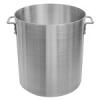Good day everyone!
I had a question that may have been answered before, however, not exactly to my current situation. If you have free time and some guidance I would appreciate the consideration!
----------------------------------------------------------------
Condensation has been building up on the hood vents and the trough around the lining of the vent which is either directly or within 1.5' of our cooking vessels. Raw ingredients are transferred into the vessels from this point as well.
I noticed some dripping coming from a hole in the trough, which I found was made before my time to solve the issue of condensation pouring out of the trough in random areas. When I saw water dripping onto employees and, potentially, raw ingredients, I cleaned the hood vent trough, had the employees change their smocks, and let the maintenance manager know that we needed a permanent solution. His solution was to patch the hole back up, which to me sounds like I'll be dealing with the issue again very soon!
I called attention to this through direct conversation and emails between myself (QA Manager / Asst. Production Manager), the owner, and the Production Manager, citing many of the well known cases (Delta, Whole Foods, etc.) of warning letters along with CFR 110.20 (b) (4), to which I got the following replies:
"Let's only escalate for persistent, bigger safety problems" and "For situations like this all that is needed...is to apply silicone" and "What is the problem with water from condensation dripping in the food that is being cooked and boiled?"- Owner
"Cover the hole with...silicone solution...and have the night crew clean any accumulation of water before they start cleaning" - Production Manager
----------------------------------------------------------------
I took the silicone solution as a slap, as the entire reason for that hole was condensation buildup from my investigation, and felt like there was little support for the potential of unintentional adulteration. That's another gripe for another day!
So! For all of the veterans of Quality, Food Safety, Regulatory, and 3rd party auditing schemes: What is the next move?
I did say very explicitly that in the event this occurs on my watch the food will be destroyed, and if there's any push back, I'll contact who I deem necessary for further guidance. I know it's not top marks for professionalism but I didn't rise to this station by kowtowing to every business owner that demeaned my position. :-)
Edited by semajzemog, 11 May 2023 - 04:03 PM.
















